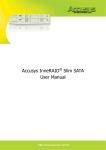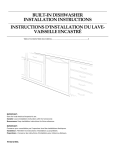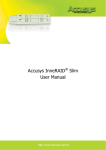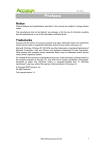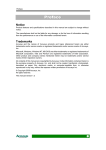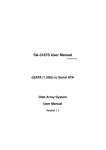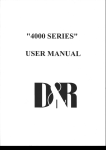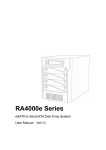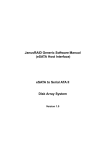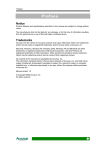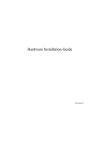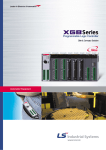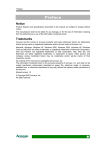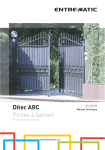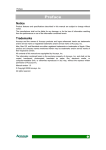Download Mounting RAID box
Transcript
User’s manual P Prre effa ac ce e Notice Product features and specifications described in this manual are subject to change without notice. The manufacturer shall not be liable for any damage, or for the loss of information resulting from the performance or use of the information contained herein. Trademarks Accusys and the names of Accusys products and logos referenced herein are trademarks and/or service marks or registered trademarks and/or service marks of Accusys, Inc. Microsoft, Windows, Windows NT, MS-DOS are either trademarks or registered trademarks of Microsoft Corporation. Intel and Pentium are registered trademarks of Intel Corporation. Other product and company names mentioned herein may be trademarks and/or service marks of their respective owners. All contents of this manual are copyrighted by Accusys, Incite information contained herein is the exclusive property of Accusys, Inc. and shall not be copied, transferred, photocopied, translated on paper, film, electronic media, or computer-readable form, or otherwise reproduced in any way, without the express written permission of Accusys Inc. © Copyright 2008 Accusys, Inc. All rights reserved. This manual version 1.1 www.accusys.com.tw User’s Manual About this manual Intended user This manual is designed and written for users of the ACS-76200 RAID box. The user should ideally be familiar with RAID planning and data storage operations and have experience in electronic or computer engineering. Organization of the manual This manual consists of the following sections: Chapter 1: Introduction provides details of key features, checklists of package contents and user requirements, and an overview of the RAID box and its features. Chapter 2: Before you begin contains all the information you need to decide whether to set up a RAID 0, RAID1 or RAID 5 array and lists important pre-installation notices. Chapter 3: Setting up the RAID box guides you through process of installing ACS-76200 in a system or externally and explains how to replace drives. Chapter 4: Initializing the array explains how to launch the automatic initialization process. Chapter 5: Maintenance explains how to reconfigure the RAID, instructions of connecting RS-232 and updating firmware. Chapter 6: Management explains how to scheduling backup function through StorConn GUI management software. Appendix A: FAQ helps you deal with encountered problems in the form of Q&A. Appendix B: Glossary defines relevant technical terms used in this manual. Appendix C: Specifications list technical specification of ACS-76200. Appendix D: Regulatory Information provides information of related certification and standards. Appendix E: Contact Us lists contact details of Accusys business units around the world. www.accusys.com.tw User’s manual Using this manual This guide contains all the information you need to set up and start using your RAID box and to monitor its performance in real time. The setup process will follow these steps: Prepare: Familiarize yourself with the features and capabilities of ACS-76200 (Chapter 1) Decide whether to set up a RAID 0 , RAID1 or RAID 5 array (Chapter 2) Configure: Set up the RAID box (Chapter 3) Install: Attach the necessary cables and either mount the RAID box inside your system (Chapter 3) Initialize: Initialize the array (Chapter 4) Maintenance: Maintain and reconfigure the array and update firmware of RAID box (Chapter 5) Management: Schedule the backup frequency by setting time and date or manually backup the data at any time (Chapter 6) When you have reached this point, your RAID box will be ready for use. To get the most from ACS-76200, you should also set up the StorConn GUI on your system. With this browser you can monitor the status of your array at any time and from any computer on your LAN. You will find full installation instructions and information on the monitoring capabilities of StorConn in the StorConn User’s Manual. www.accusys.com.tw User’s Manual Guide to Conventions Important information that users should be aware of is indicated with the following icons: Caution This icon indicates the existence of a potential hazard that could result in personal injury, damage to your equipment or loss of data if the safety instruction is not observed Note This icon indicates useful tips on getting the most from your RAID box. Important terms, commands and programs are put in Boldface font. Screen text is given in screen font. www.accusys.com.tw User’s Manual T Ta ab blle eo off C Co on ntte en ntts s P P R E F A C E PR RE EF FA AC CE E ................................................................................................................. 1 NOTICE....................................................................................................................... 1 TRADEMARKS ............................................................................................................ 1 ABOUT THIS MANUAL ................................................................................................. 2 Intended user........................................................................................................................................ 2 Organization of the manual ................................................................................................................. 2 USING THIS MANUAL .................................................................................................. 3 GUIDE TO CONVENTIONS ........................................................................................... 4 T T A B L E O F C O N T E N T S TA AB BL LE EO OF FC CO ON NT TE EN NT TS S .................................................................................. 5 CHAPTER 1 .................................................................................................................... 7 IIIN N T R O D U C T O N NT TR RO OD DU UC CT TIIIO ON N................................................................................................. 7 OVERVIEW ................................................................................................................. 7 KEY FEATURES ........................................................................................................... 8 Hard drive hot swapping ..................................................................................................................... 8 Automatic drive rebuilding .................................................................................................................. 8 MAKING SURE YOU HAVE EVERYTHING ...................................................................... 8 What's in the box.................................................................................................................................. 8 What else you need............................................................................................................................... 8 FAMILIARIZING YOURSELF WITH THE RAID BOX ....................................................... 9 Overview .............................................................................................................................................. 9 Front view ............................................................................................................................................ 9 Rear view ........................................................................................................................................... 10 CHAPTER 2 .................................................................................................................. 11 B B E F O R E Y O U B E G N BE EF FO OR RE EY YO OU UB BE EG GIIIN N .................................................................................... 11 PRE-INSTALLATION PLANNING ................................................................................. 11 Introduction to RAID levels ............................................................................................................... 11 RAID 0 ............................................................................................................................................... 12 RAID 1 and 1+Spare ......................................................................................................................... 13 RAID 5 ............................................................................................................................................... 15 PRE-INSTALLATION NOTICES .................................................................................... 16 CHAPTER 3 .................................................................................................................. 17 S S E T T N G U P T H E R A D B O X SE ET TT TIIIN NG GU UP PT TH HE ER RA AIIID DB BO OX X .................................................................. 17 INSTALLATION FLOWCHART ..................................................................................... 17 SETTING CONFIGURATIONS ...................................................................................... 18 2-drive RAID 0 configuration ............................................................................................................ 18 3-drive RAID 0 configuration ............................................................................................................ 18 RAID 1/1+S/1+B configuration......................................................................................................... 18 RAID 5 configuration......................................................................................................................... 18 MOUNTING RAID BOX ............................................................................................. 20 Mounting RAID box in system ........................................................................................................... 20 LOADING DRIVES IN THE RAID BOX......................................................................... 21 Install drive into carrier..................................................................................................................... 21 CHAPTER 4 .................................................................................................................. 23 IIIN N T A L Z N G T H E A R R A Y NIIIT TIIIA AL LIIIZ ZIIIN NG GT TH HE EA AR RR RA AY Y .................................................................... 23 CHAPTER 5 .................................................................................................................. 24 M M A N T E N A N C E MA AIIIN NT TE EN NA AN NC CE E ................................................................................................ 24 RE-CREATING RAID ................................................................................................ 24 REMOVING/REPLACING A DRIVE ............................................................................... 24 Swapping drives ................................................................................................................................. 24 www.accusys.com.tw User’s Manual What if a disk fails.............................................................................................................................. 25 Removing a drive from a fixed connector drive carrier..................................................................... 25 FIRMWARE UPDATING STEPS .................................................................................... 26 CHAPTER 6 .................................................................................................................. 28 M M A N A G E M E N T MA AN NA AG GE EM ME EN NT T ................................................................................................. 28 Schedule setting (Only for RAID 1/1+Spare/1+Backup)................................................................... 28 RAID capacity expansion and level migration................................................................................... 29 RAID capacity expansion and level migration steps: ........................................................................ 30 APPENDIX A ................................................................................................................ 32 F F A Q FA AQ Q ............................................................................................................................. 32 APPENDIX B ................................................................................................................ 34 G G L O S S A R Y GL LO OS SS SA AR RY Y ........................................................................................................... 34 APPENDIX C ................................................................................................................ 35 S S P E C F C A T O N S SP PE EC CIIIF FIIIC CA AT TIIIO ON NS S ............................................................................................ 35 APPENDIX D................................................................................................................ 36 R R E G U L A T O R Y N F O R M A T O N RE EG GU UL LA AT TO OR RY Y IIIN NF FO OR RM MA AT TIIIO ON N ........................................................... 36 APPENDIX E ................................................................................................................ 37 C C O N T A C T U S CO ON NT TA AC CT TU US S ...................................................................................................... 37 ACCUSYS, INC. ......................................................................................................... 37 ACCUSYS U.S.A., INC. ............................................................................................. 37 ACCUSYS KOREA, INC.............................................................................................. 37 ACCUSYS CHINA, INC............................................................................................... 37 世仰科技北京代表处 ............................................................................................. 37 ACCUSYS EU, BV. ................................................................................................... 38 www.accusys.com.tw User’s Manual Chapter 1 IIn nttrro od du uc cttiio on n This chapter introduces the features and capabilities of ACS-76200. You will find: Ö A full introduction to your ACS-76200 RAID box Ö Details of key features Ö A checklist of package contents Ö A checklist of what else you need to start installation Ö Ö An overview of the RAID box and its features, including connectors, LEDs and jumpers Overview Congratulations on your selection of the ACS-76200. The ACS-76200 is a high-performance and extremely flexible RAID (Redundant Array of Independent/Inexpensive Disks) controller. RAID is a storage technology used to improve the processing capabilities of a storage system, providing a combination of reliability and performance. The ACS-76200 is the ultimate approach to a flexible RAID solution. It can manage four different RAID levels (2 bays R0, 3 baysR0, 1+Backup or Spare and R5), with three SATA disks in a single RAID group. With a cost-effective SATA approach, supporting Ultra DMA mode, the ACS-76200 strips data to three disk drives simultaneously, and delivers optimized performance, comparable to more costly SCSI based solutions. Featuring intelligent online recovery, the ACS-76200 lets you hot swap a failed drive: data will automatically be rebuilt to the new drive without any system down time. If RAID 1 or RAID 5 array exists and one SATA disk drive fails, data is secured by the other drives, and an alarm sounds to alert you. RAID 5 rebuild will proceed automatically (during power on) as soon as you lock the disk carrier. If a RAID 0 array fails, there is no way to recover the data of the RAID system. You should proceed by reconfiguring the new RAID with a new SATA disk. The ACS-76200 RAID box features a user-friendly rack design that lets you easily install three hard drives. Each drive carrier supports a one-inch high 3.5-inch form factor drive. Security is provided by a key-locking system that prevents unauthorized access to each disk drive. www.accusys.com.tw User’s Manual Key features The ACS-76200 supports the following features: z Support three SATA-2 compatible disk drives z Support one SATA-2 compatible host channel z Support RAID level 2 bays R0, 3 baysR0, 1+Backup or Spare and R5 z Drives are hot swappable z Host transparent and OS independent z Fan cooler (Vapo bearing type) z Support ATA-6 big drive z Key locking to prevent unauthorized access to the disk drives z Audible alarm on drive failure z Automatic drive failure detection z Automatic online rebuilding z Battery backup for disk rebuild status z Support over 2T z Support Firmware update via RS232 interface z RAID capacity expansion by GUI z RAID level migration by GUI Hard drive hot swapping Hot Swapping allows for the removal and installation of disk drives without the need to power down the system while ACS-76200 is configured as RAID1 or RAID 5 array. Automatic drive rebuilding If a member drive in RAID1 or RAID 5 array is replaced on-line, the RAID box will automatically start to rebuild data to the new drive. Making sure you have everything What's in the box Some vendors may ship certain components as standard, while other vendors treat the same component as optional. In its most basic configuration, your package should include the following: z ACS-76200 RAID box z ACS-76200 RAID box User’s Manual and GUI management software z Three disk drive carriers z Disk drive mounting screws z Two keys for drive carriers (identical) z One 3-pin RS232 cable connector z One DB9 cable connector for COM port to RS232 connection What else you need In order to setup a working system the following user-supplied items are required: z System with SATA Interface z Case with two half-height 5 ¼” drive bays with front bezel access z One SATA channel cable connector z One free power supply connector at least z One 3-pin RS232 cable connector (data connection for GUI interface, if required) www.accusys.com.tw User’s Manual Familiarizing yourself with the RAID box Overview The RAID box has three drive carriers, accessed from the front. The sides of the box each feature a guide rail channel and mounting screw holes to enable the box to be secured inside a computer case. The connectors and jumpers are located on the rear panel. n o p q RAID box Drive carriers Holes for mounting screws Guide rail channel Front view Each drive carrier can hold a one-inch high 3.5-inch form factor SATA disk drive. This makes it easy to hot swap a drive in the event of a failure, without affecting the status of the remaining drives. n Carrier handle bar o Lock-release hole p Disk Status Indicator (Green/Red) q Disk Access Indicator (Blue) Disk activity indicators These indicators show the status of each individual disk drive. Disk Status Indicator RAID status Descriptions Solid Green Disk Access Indicator Off Solid Green On/Flash Disk is being accessed Solid Red Alternating Green and Red Off On/Flash No disk installed or disk failure Disk is rebuilding or being initialized* Disk is properly installed In the event that a drive fails, the Red indicator turns on and an alarm sounds. You can turn off the alarm by pulling the drive carrier out. www.accusys.com.tw User’s Manual Release the lock of drive carrier The drive carrier lock provides security by preventing non-key holders from accessing the drives. To un-lock the carrier, insert the key to the released- hole, and then push the key to the left side to release the handle bar, hold the handle bar to pull out the drive carrier. Rear view The SATA cable is the route used for reading and writing to the array. The power connector supplies power to the RAID box. In order to provide stable power, we recommend to connect both power connectors on the RAID box. The 3-pin RS-232 cable is used for remote monitoring of ACS-76200. The RS-232 port is configured with DTE and PC compatible pin assignments. There is a triangular symbol “▲” on both PCB connector and RS-232 cable connector, please make sure you connect in the right direction (both triangle symbols match each other). Connecting in wrong direction will not damage RAID box, however the terminal or GUI will not work. The cooling fan inside the RAID box provides air circulation for the disk drives. n Connector for SATA interface cable o RAID level configuration jumper pins p 3-pin RS232 connector (Terminal port) q 8-pin setting jumper r Cooling fan vent s Power connectorx2 www.accusys.com.tw User’s Manual Chapter 2 B Be effo orre ey yo ou ub be eg giin n This chapter contains all the information you need to decide which RAID level to use and to prepare for installation. You will find: Ö A full introduction and comparison of RAID levels 0, 1 and 5 Ö Ö Important notices on the safe operation and installation of ACS-76200 Pre-installation planning Introduction to RAID levels The ACS-76200 can support the following RAID levels: 2 bays R0, 3 bays R0, R1+Backup or Spare and R5. Which is the right level for you? The answer depends on the application that it is used for. RAID Level 0 offers high transfer rates, and is ideal for large blocks of data where speed is of importance. Computer Aided Design, Graphics, Scientific Computing, Image and Multimedia applications are all good examples. If one drive in a RAID 0 array fails however, the data on the whole array is lost. RAID Level 1 supports three disk channels with the “spare and backup” function. It is the function of sequence to turn on and off one disk to be the backup disk in order to keep the data for rebuild when two disks data crash at the same time. It automatically turns off one disk and always keeps two disks for RAID 1 operation. The Off-line disk will be turned on and one of on-line disk will be turned off to do the daily backup function. RAID 1+Spare allows users to set RAID 1 with two drives and the third drive as a “hot spare” ready to be used for rebuilding data in case one of the other drives fails. The time scheduling backup function is through StorConn GUI management software to do it. Further information on StorConn GUI management software to do backup function can be found in Chapter 6, Management. RAID Level 5 arrays offer high I/O transaction rates, and are the ideal choice when used with on-line transaction processing applications, such as those used in banks, insurance companies, hospitals, and all manner of office environments. These applications typically perform large numbers of concurrent requests, each of which makes a small number of disk accesses. If one drive in a RAID 5 array fails, the lost data can be rebuilt from data on the functioning disks. Further information on RAID concepts can be found in Appendix B, Glossary. www.accusys.com.tw User’s Manual RAID 0 RAID 0 links each drive in the array as one huge drive. Storage capacity is determined by the smallest drive in the array. That capacity is then applied to format all other drives in the array. If using a 40 GB, 60 GB, and 50 GB drive in a RAID 0 array, your system will see one huge drive of 120 GB (40 GB×3). RAID 0 offers double or more performance under sustained data transfers when one drive per ATA port is used. In such a configuration, unlike SCSI, ATA drives are always available to the system. SCSI requires more management of the SCSI bus. RAID 0: Striped disk array without fault tolerance Characteristics: Recommended use: RAID 0 implements a striped disk array, the data is broken down into blocks and each block is written to a separate disk drive. I/O performance is greatly improved by spreading the I/O load across many channels and drives. Fastest and most efficient array type but offers no fault-tolerance. Storage capacity = (No. of disks) × (capacity of smallest disk) Video production and editing Image editing Pre-press applications Any application requiring high bandwidth Arrangement of data blocks saved on a RAID Level 0 array Note The ACS-76200 supports 2-drives and 3-drives RAID 0 by switch. www.accusys.com.tw User’s Manual RAID 1 and 1+Spare RAID 1 is commonly referred to as Disk Mirroring, Disk Shadowing or Disk Duplexing as all data is duplicated across both disks. RAID 1 can only be performed with two hard drives (with three drives, RAID 1+Spare is configured automatically, the third drive as a hot-spare drive ready to be used for rebuilding data in case one of the other drive is fail.). As data is identical on both disks, storage capacity is that of the smaller disk. RAID 1 has poor performance for write operations but very high performance for read intensive operations. RAID 1: Mirroring Characteristics: Recommended use: Better Read transaction rate then single disks, same Write transaction rate as single disks. 100% redundancy of data means no rebuild of data is necessary in case of disk failure, just a copy to the replacement disk. All the disks have the same data. Raid level 1 requires two drives. Storage capacity = Capacity of smaller disk Accounting Payroll Financial Any application requiring high availability Arrangement of data blocks saved on a Level 1 array www.accusys.com.tw User’s Manual Backup function When executing the backup feature, the controller turns the Disk 2 to be backup and the Disk 3 to be RAID member disk. The controller continues to mirror data from the Disk 1 to the Disk 3. The backup function is available only when the RAID is safe. If the RAID health is in good state, you may execute the backup function. The RAID health refers to the state of both the source and target HDD. Failure of either of the HDDs causes unsafe RAID. The backup function can only be executed through GUI. Note To balance the HDD usage for extending the life, the HDD will exchange after the data scheduling backup. www.accusys.com.tw User’s Manual RAID 5 RAID 5 uses a mathematical expression that compares data from two drives and calculates a third piece of data called “parity”. Should one of the drives fail, parity data can be used to rebuild the failed data. Under RAID 5, parity data is stored across all drives in the array. This maximizes the amount of storage capacity available from all drives in the array while still providing data redundancy. RAID 5: Independent data disks with distributed parity blocks Characteristics: Recommended use: Each entire data block is written on a data disk. Parity for blocks in the same rank is generated on Writes, recorded in a distributed location and checked on Reads. Highest Read data transaction, medium Write data transaction rate. Relatively low ratio of ECC (Parity) disks to data disks means high efficiency (compared to other RAID levels). Good aggregate transfer rate. Storage capacity = (No. of disks – 1) × (capacity of smallest disk) File and application servers Database servers WWW, E-mail and News servers Intranet servers Most versatile Raid level Arrangement of data blocks saved on a RAID Level 5 array www.accusys.com.tw User’s Manual Pre-installation notices Caution Before starting any kind of hardware installation, please ensure that all power switches have been turned off and all power cords disconnected to prevent personal injury and damage to the hardware. Caution To avoid overheating, ACS-76200 should be installed in a well-ventilated area and in such a way that sufficient airflow is maintained across the chips. Caution Static electricity can damage electronic components. To guard against such damage: Work in a static-free environment Wear a grounded anti-static wrist strap Store uninstalled components in anti-static bags Handle PCBs by their edges and avoid touching chips and connectors. Caution Environmental requirements: Temperature: Operating Temp: 0℃ to 40 ℃ Storage Temp: -25℃ to 60℃ Humidity: Operating Humidity: 5% to 85% non-condensing Storage Humidity: 5% to 95% non-condensing www.accusys.com.tw User’s Manual Chapter 3 S Se ettttiin ng gu up p tth he eR RA AIID Db bo ox x This chapter explains how to: Ö Set RAID level on RAID box Ö Install the RAID box in a system or externally Ö Load hard drives into ACS-76200 Ö Ö Swap drives Installation flowchart Installation of ACS-76200 is simple. This chapter will lead you though the following steps: Set RAID level z Use the RAID level selector to set the RAID level (2 bays R0, 3 baysR0, 1+Backup or Spare and R5) by demand Connect to the host computer z When the RAID box is fully configured, connect a power and SATA cable and install it either in a system. Initialize the array z Load drives into the RAID box and begin initializing the array The RAID box is ready to be used www.accusys.com.tw User’s Manual Setting configurations The RAID (2 bays R0, 3 baysR0, 1+Backup or Spare and R5) is set by using the RAID level selector on the rear panel of RAID box. The RAID level selector consists of two switches. The two combinations of switch position correspond to the two available RAID level settings: 2-drive RAID0, 3-drive RAID0, RAID1/1+S/1+B and RAID 5. 2-drive RAID 0 configuration 1. Make sure the power is turned off. 2. Move both selector switches 1 and 2 to ON as shown. 3-drive RAID 0 configuration 1. Make sure the power is turned off. 2. Move selector switch 1 to OFF and 2 to ON as shown RAID 1/1+S/1+B configuration 1. Make sure the power is turned off. 2. Move selector switch 1 to ON and 2 to OFF as shown RAID 5 configuration 1. Make sure the power is turned off. 2. Move both selector switches 1 and 2 to OFF. Support over 2TB via setting jumper 1. Make sure the power is turned off. 2. Place one jumper cap over the second pair Note The device over 2TB capacity should be supported by Operation System (e.g. Windows Vista). Please refer to page 31 Formatting drive over 2TB capacity on Windows Vista to partition the over-2TB-device. www.accusys.com.tw User’s Manual Note If you already enable over 2T in your RAID. Please don’t remove this jumper before you want re-initial RAID again. Otherwise some data will lose. Note If you want to enable support over 2TB function, please setting jumper before the array init. www.accusys.com.tw User’s Manual Mounting RAID box The ACS-76200 RAID box can be installed inside a computer case. This section describes both procedures. Caution Turn off and disconnect all electrical power from the system before beginning installation. Caution Undefined jumpers are for factory setting only that they are prohibited to use. Please put the jumper carefully, otherwise it will cause the system damage Mounting RAID box in system The ACS-76200 RAID box fits into the space of two half-height 5¼-inch drive bays. 1. Remove the cover and front bezel from the system case. 2. Feed a power cable n through the opening. 3. Feed an SATA cable o through the opening. 4. Connect the two cables to the connectors on the rear of the RAID box. 5. If planning to use the StorConn GUI to monitor the status of your RAID, you should also connect a 3-pin RS-232 cable to the terminal on the RAID box. www.accusys.com.tw User’s Manual 6. Insert the RAID box into the bay, and secure it in place with the screws provided. (If your case uses guide rails to install 5¼-inch devices, you can use them on the RAID box.) Note In order to provide stable power, we recommend connecting both power connectors on the RAID box. Loading drives in the RAID box Install drive into carrier The ACS-76200 should be fitted with two hard disk drives. Load each drive into a drive carrier as follows: 1. Release the handle bar by key stick and slide drive carrier out of the RAID box. 2. Place the disk drive in the carrier, so that the SATA connector is lined up with the connector inside the carrier. 3. Secure the disk drive by screwing it to the drive carrier case. 4. Slide the loaded disk drive carrier into the RAID box and push down the handle bar to lock the carrier. www.accusys.com.tw User’s Manual Note The SATA connector of disk is directly contact to RAID box, so please mount disk drive to carrier firmly for preventing the damage to the connector on both RAID box and disk. Note The disk carrier connector at the back of each RAID box disk carrier slot can be damaged if the disk carrier is not properly aligned when inserted. Insert the disk carrier gently to avoid damage. www.accusys.com.tw User’s Manual Chapter 4 IIn niittiia alliiz ziin ng g tth he ea arrrra ay y Once ACS-76200 is set up and connected, the array should be initialized. The initialization process is automatic. z z If system power is off and ACS-76200 is fully set up, simply turn on system power. The system will detect the presence of ACS-76200 and ACS-76200 will check the status of the hard disks. Initialization will start. If system power is already on, key off then key on each of the drives in turn. You should wait for the green disk status indicator to light for each drive before keying on the next drive. Disk Status Indicator RAID status Descriptions Solid Green Disk Access Indicator Off Solid Green On/Flash Disk is being accessed Solid Red Off No disk installed or disk failure Disk is properly installed If a red disk status indicator shows, check to make sure the appropriate drive is: z Locked z Installed correctly z Not faulty (if necessary, the drive should be replaced). During array initialization, the following will be observed: Disk Status Indicator Alternating Green and Red Disk Access Indicator On/Flash RAID status Descriptions Disk is rebuilding or being initialized* Note If system power is turned off midway through array initialization, the process will continue from its point of interruption when power returns. www.accusys.com.tw User’s Manual Chapter 5 M Ma aiin ntte en na an nc ce e This chapter explains how to reconfigure the ACS-76200 and update firmware. Re-creating RAID If intend re-creating a new RAID from current configuration, please follow the instructions: 1. Remove all disk drives while power on status. 2. Power off the RAID box. 3. Set RAID level selector to the RAID level that you desired. 4. Power on the RAID box again, wait until hear the beep sounds. The RAID box is reset. 5. Insert and lock the disk drives 6. With RAID 0, RAID1 or RAID 5 array, the initialize will begin when three disks are installed and detected. Caution Re-creating array with original hard drives to different RAID level will destroy all of data that saved on the hard drives. Removing/replacing a drive Swapping drives The hot swap function is available on the RAID 1 and RAID 5 array and can be operated during run time. RAID rebuilding will be processed automatically in the background and the ACS-76200 RAID subsystem will record its progress. If the host system is shut down or powered off abnormally, the ACS-76200 RAID subsystem will continue the disk rebuilding process after power is turned on again. Note A hard disk should not be replaced when the system is turned off. Doing so may leads to loss of data. Always hot swap disks in the RAID1 and RAID5 array. www.accusys.com.tw User’s Manual What if a disk fails If a disk drive fails, or a key switch is turned off, the red disk activity indicator of its disk carrier will light and the alarm will sound. When this happens, you can replace the failed SATA disk with a new one, and then turn the key switch on. Note The failure or removal of a single drive in RAID1 and RAID5 array will not lead to failure of the array. The failure or removal of a single drive in a RAID0 array will lead to loss of all data on the array and the entire array must be re-initialized. Removing a drive from a fixed connector drive carrier 1. Insert the key to keyhole, push key to left side for releasing the handle bar. 2. Hold handle bar and pull out the drive carrier from RAID box. 3. Loose screws from drive carrier. 4. Lift out the disk drive. www.accusys.com.tw User’s Manual Firmware updating steps 1. Ensure your ACS-76200 is turned off. 2. Connect one end of the supplied RS-232 cable to the RS-232 3pin port from the Pin1, 2, 3 of the terminal port on your ACS-76200, and connect the DB9 cable connector from the 3-pin RS232 DB9 port to one of the host computer’s COM port. 3. Launch HyperTerminal from the host computer: Start > Programs > Accessories > Communications > HyperTerminal. 4. Select COM1 or COM2 from the Connect using: dropdown menu, depending on which port is connecter to ACS-76200. 5. The COM port properties dialog box will appear. Set the following values then apply: Bit per second: 19200 Data bits: 8 Parity: None Stop bits: 1 www.accusys.com.tw User’s Manual 6. Turn on the ACS-76200 and press the ESC button on the host computer keyboard. The “>>>” prompt will appear. 7. Type in the command “download” to go to the firmware download mode, then type “1” to download code (Firmware or Boot code). >>> download Restart …FF9E Enter 01 AGPIO 01 RAID level = 01 01 AAA 01 ‘1’ to Download Code (Firmware, Boot code) ‘ESC’ exit ‘r’ 01 reset --------------------------- version: Boot ---- 10 (a) ---- 04 Downloading Code! Flash type: SST39VF040 8. Locate the updates firmware file to send. For HyperTerminal, go to the Transfer menu and select Send Text File. 9. Send the firmware file as a text file. And find the path of file. The file will start to download. 10. When the F/W has been downloaded, after ACS-76200 restarted, the firmware updating procedure is finished. Then it’s necessary to power off and power on the ACS-76200 again to let the F/W affect. Caution DO NOT turn off the system or interrupt the program during firmware-updating procedure. www.accusys.com.tw User’s Manual Chapter 6 M Ma an na ag ge em me en ntt This chapter explains how to scheduling backup function and RAID capacity expansion and level migration through StorConn GUI management software. Schedule setting (Only for RAID 1/1+Spare/1+Backup) Schedule system backup. This feature support only RAID 1/1+Spare/1+Backup, which allows you to arrange system’s backup schedule so that system data can be periodically saved with a copy. Other than this, you may select manual backup at any time you want. Two ways can be set up the schedule, one is select form StorConn server and the other is select form Monitor Windows. Set up the schedule form StorConn server: 1. The StorConn server icon appears on the task bar at the bottom right of the desktop. You can single click right bottom for option menu. 2. Click Schedule Setting and the Backup dialog box pops out on the screen. 3. Adjust the following settings: Choose Controller: Specify the target controller that you would like to backup your data from. (Set up the schedule form Monitor Windows without choose controller) Manual Setting: Allows you to backup system data manually and at any time you need. Schedule Setting: Set up the Frequency, Time, Day of Week and Day for backup work. Last Backup: Display information about the time and date of last backup Set up the schedule form Monitor Windows: www.accusys.com.tw User’s Manual 1. Click Backup Setting form Monitor Windows and the Backup dialog box pops out on the screen. 2. The Backup Setting dialog box pops out on the screen. 3. Adjust the following settings: Manual Setting: Allows you to backup system data manually and at any time you need. Schedule Setting: Set up the Frequency, Time, Day of Week and Day for backup work. Last Backup: Display information about the time and date of last backup. RAID capacity expansion and level migration The ACS-76200 supports the following RAID reconfigurations: (1) 2-drive R0 to 3-drive R0 (expansion) (2) 3-drive R1/1+B/1+S to 3-drive R5 (expansion and migration) (3) 2-drive R0 to 3-drive R5 (expansion and migration) The reconfiguration is started by the in-band/out-band GUI commands, and it can be done only when all disk drives in the original RAID are healthy. After the reconfiguration GUI command is received, the ACS-76200 will start doing the reconfiguration after it is restarted. During the reconfiguration, the ACS-76200 will also stop serving any host commands and the host computer cannot detect the ACS-76200. After the reconfiguration is done, the ACS-76200 will start serving host commands after it is restarted. Note The original RAID level can’t be restored after the RAID expansion. www.accusys.com.tw User’s Manual RAID capacity expansion and level migration steps: 1. Click Expand Setting form Monitor Windows and the Expansion dialog box pops out on the screen. 2. Adjust the following settings: Manual Setting: a. Allow you to select which available RAID level that you want to change. b. Click OK to process the RAID expansion. 3. Please follow the steps of Message to let Array expand effective Note Controller will scan the spare disk before start expanding to make sure the drive is healthy, if the spare disk has bad sector, it will be kicked off. Caution During the expansion process, please don’t turn off the system or pull out disk. Caution Risk of Explosion if Battery is replaced by an Incorrect Type. Dispose of Used Batteries According to the Instructions www.accusys.com.tw User’s Manual Note If set up the state of the disk into a Dynamic disk, the expand function only can be use in 2R0 to R5. www.accusys.com.tw User’s Manual Appendix A F FA AQ Q If you encounter a problem while using the ACS-76200, check this section for help. 1. When I lock a drive carrier with a disk drive in place, the red disk activity indicator turns on and an alarm beep sounds. Why? (a) Make sure you firmly connect the SATA connector of the HDD to their counterparts inside the drive carrier and try again. If this does not solve the situation, go to (b). (b) Change the disk drive with a new one and try again. (c) Exchange the top and bottom drive carriers and try again to determine if the carrier itself is faulty. (d) If all of the above steps fail, contact your vendor. 2. How can I turn off the alarm beep sound when there is a hard disk failure? Take off the failure HDD that the beeper will stop and we strong to suggest to replace a new HDD when the drive is fail. 3. I have connected the RAID Box, but it does not appear in the motherboard BIOS. Why? Ensure that an array is initialized. 4. Formatting drive over 2TB capacity on Windows Vista The steps below will guide you to format a drive over 2TB capacity at Window Vista. Caution Formatting drive will crash all data in the drive. (a) Right click Computer and click Manage. (b) From the Computer Management window, select Disk Management. (c) Windows operation system will list all the hard drives that are installed on the system. icon. Right click the icon and Locate the ACS-76200 drive that is represented by the select Initialize Disk. (d) The Initialize Disk dialog box will appear, select the disk number and select the GPT (GUID Partition Table) partition style. (Figure 3.5.2.A) (e) In the drive box to the right shows Unallocated, right click and select New Simple Volume. (Figure 3.5.2.B) www.accusys.com.tw Appendix B – Glossary (f) The New Simple Volume Wizard dialog box will appear, click Next to continue. (g) After selecting partition type, specifying partition size and assigning drive letter, the Format Partition dialog box will appear, you have the option of selecting the Quick Format option. This allow mach fast formatting, however, this disallow Disk Management to check the drive sector for errors. Click Next to start the format process. (h) Your drive should now appear in your Computer and ready for use. www.accusys.com.tw User’s Manual Appendix B G Gllo os ss sa arry y Array See Disk Array. Array Management Software The body of software that provides common control and management for a disk array. Array Management Software most often executes in a disk Box or intelligent host bus adapter, but may also execute in a host computer. When it executes in a disk Controller or adapter, Array Management Software is often referred to as Firmware. Cache Controller memory used to speed up data transfer to and from a disk. Disk Array A collection of disks from one or more commonly accessible disk controllers, combined with a body of Array Management Software. Array Management Software controls the disks and presents them to the array operating environment as one or more virtual disks. Firmware See Array Management Software. Host Computer Any computer system to which disks are directly attached and accessible for I/O. Mainframes, and servers, as well as workstations and personal computers, can all be considered host computers in the context of this manual, as long as they have disks attached to them. Parity Parity information is redundancy information calculated from actual data values. If any single piece of data is lost, the data remaining and the parity information can be used together to compute the lost data. Parity information can either be stored on a separate, dedicated drive, or be mixed with the data across all the drives in the array. RAID (Redundant Array of Independent / Inexpensive Disks) A disk array in which part of the storage capacity is used to store redundant information about user data stored on the remainder of the storage capacity. The redundant information enables regeneration of user data in the event that one of the array member disks or the access path to it fails. See Parity. Different RAID levels offer different data throughput speeds and fault tolerance (data redundancy). RAID 0 does not feature redundant information but is nonetheless considered a special type of RAID. www.accusys.com.tw Appendix C – Specifications Appendix C S Sp pe ec ciiffiic ca attiio on ns s Host interface Disk interface RAID levels supported Form factor Dimensions Weight One SATA-I SATA-I (Support SATA-II but run in SATA-I) 2 bays R0, 3 baysR0, 1+Backup or Spare and R5 Two half height 5 ¼ inch W5.75 x H3.35 x L7.98 (inch) 3.96 (lb) Yes (Rebuilding is transparent & automatic) Yes, built-in buzzer on board Hot swap Beeper alarm FAN Rated Speed:4000 RPM +/- 15% Noise Level: 28.5dB(A) Note Specifications are subject to change without notice. www.accusys.com.tw User’s Manual Appendix D R Re eg gu ulla atto orry y iin nffo orrm ma attiio on n FCC Statement This equipment has been tested and found to comply with the limits for a Class B digital device, pursuant to Part 15 of FCC Rules. These limits are designed to provide reasonable protection against harmful interference in a residential installation. This equipment generates, uses, and can radiate radio frequency energy and, if not installed and used in accordance with the instructions, may cause harmful interference to radio communications. However, there is no guarantee that interference will not occur in particular installation. If this equipment does cause harmful interference to radio or television reception, which can be determined by turning the equipment off and on, the user is encouraged to try to correct the interference by one or more of the following measures: 1. Reorient or relocate the receiving antenna. 2. Increase the separation between the equipment and receiver. 3. Connect the equipment into an outlet on a circuit different from that to which the receiver is connected. 4. Consult the dealer or an experienced radio/television technician for help. The changes or modifications not expressly approved by the party responsible for compliance could void the user’s authority to operate the equipment. Shielded interface cables, if any, must be used in order to comply with the emission limits. CE Mark This equipment is in conformity with the EMC directive. UL Listed This equipment meets UL's safety requirements. www.accusys.com.tw Appendix E – Contact Us Appendix E C Co on ntta ac ctt U Us s Accusys, Inc. • • • • • 5F., No.38, Taiyuan St., Jhubei City, Hsinchu County 30265, Taiwan R.O.C. Tel : +886-3-560-0288 Fax : +886-3-560-0299 http://www.accusys.com.tw/ e-mail : [email protected] Accusys U.S.A., Inc. • • • • • • 46710 Fremont Blvd. Fremont, CA 94538, U.S.A. Tel:+1-510-661-0800 Fax:+1-510-661-9800 Toll-free number:+1-866-277-5888 http://www.accusysusa.com/ e-mail : [email protected], [email protected] Accusys Korea, Inc. • • • • • Baegang B/D 5F Shinsa-Dong 666-14 Kanggnam-Gu, Seoul, Korea Tel : (02)6245-9050 Fax : (02)3443-9050 http://www.accusys.co.kr/ e-mail : [email protected] Accusys China, Inc. • • • • • • • #1701, Blk B, Horizon International Tower, No. 6 Zhichun Street, Haidian District, Beijing, China China Postal Code:100088 Tel: +86-10-82800080 /81 /82/ 83 Fax: +86-10-82800784 Web: www.accusys.com.cn Sales: [email protected] Support: [email protected] 世 世仰 仰科 科技 技北 北京 京代 代表 表处 处 • • • • • • • 地址: 北京市海淀区知春路 6 号 锦秋国际大厦 B 座 1701 邮编: 100088 电话: +86-10-82800080 /81 /82 /83 传真: +86-10-82800784 网址: www.accusys.com.cn Mail: [email protected] Support: [email protected] www.accusys.com.tw User’s Manual Accusys EU, BV. • • • • • Columbusstraat 22-26, Distripark Eemhaven, 3165 AD Rotterdam, Netherlands Tel : +31-10-2995761 Fax : +31-10-4292194 Http://www.accusyseu.com e-mail : [email protected] www.accusys.com.tw







































